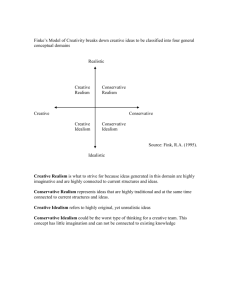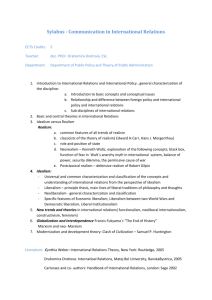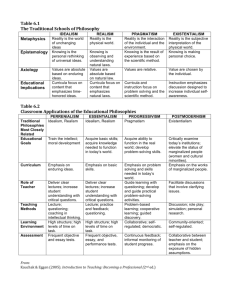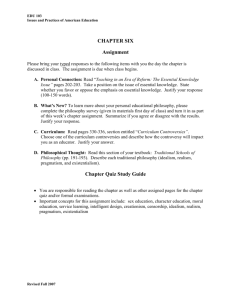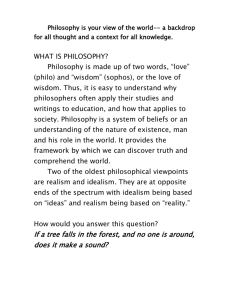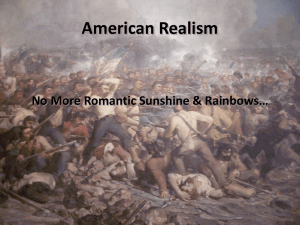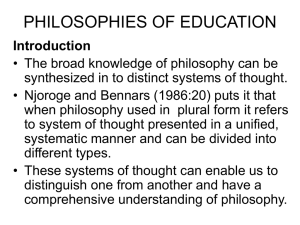IR Unit I Power Point Online
advertisement
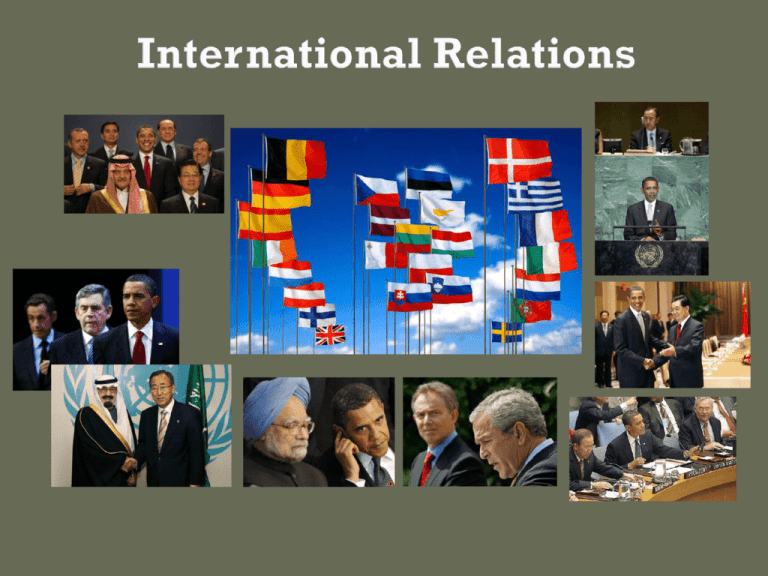
International Relations: how countries relate to one another, how they work together, and how they conflict. A state or country is an independent, defined territory with a government, a population, and sovereignty over these. State sovereignty gives nations the right to carry out laws and policies within its borders without interference from other states What’s another word for state? State and country mean exactly the same thing. • A group of people with a distinct identity. • What do these people share in common? race ethnicity history culture language religion Interstate (or international) “Between states” Intrastate “Within a state” “Underlying the behavior of nations is the concept of national interest” What question does this statement answer? Why do nations behave the way they do? What is best for a particular country Anything that is good for or beneficial to a country. The goals viewed as being beneficial to a country… … and that determine that country’s behavior. A Country’s National Interests / Goals A Country’s Behavior (It’s Foreign Policy) • A country’s national interests change over time. • Each country’s interests are unique, but all countries share these broad goals: State sovereignty Territorial integrity Military security Economic well-being Citizens often disagree on what their country’s national interests are. National interests are ultimately defined by a country’s leaders. A country’s national interests will determine its foreign policy. Combines Security, Economic and Ideological concerns of a country Must meet basic needs so it can survive and improve it’s citizens’ living standards Examples of a nation’s basic needs… 1. Survival concerns: Mali and Bangladesh 2. Development of Natural Resources to trade: Niger and Malaysia Physical survival is a universally shared concern. We build armies, create alliances Sense of national security is based on perceived threats from other nations. 1. Israel: few allies/strong military 2. Switzerland: few enemies/no large army Countries seek to promote economic welfare Countries vary in economic interests • Depends on availability of resources • Depends on development of resources Need to obtain basics first (food, water, shelter, health care) Lack agricultural methods and industrial developments to provide these • Cash crops/ raw materials are often traded for food • Attract foreign investment and tourism to supplement national income • Example: Sub-Saharan Africa Turn out a variety of products including processed food, machinery, autos, computers, clothing etc. Production often exceeds actual needs • Excess of manufactured goods is exported in exchange from raw materials, products or money • Economic growth is dependent upon ability to buy or sell products abroad. • Economic interests are determined by wants and needs of citizens, types of products to sell, and development of the economies Ideology is a combination of beliefs, values, culture, religion, and historical experiences of a nation’s people • Plays a unique role in National Interest • Countries are interested in protecting a way of life and trying to promote that abroad a) Example of US: promoting democracy in dictatorial nations b) Example of Iran: promotes religion of Shiite Islam. Concerns do not exist independently (economic interests affect security and ideological interests) • Example: If people do not have enough to eat, the stability and therefore the security of government may be threatened • Example: Some nations believe that the security of their nation depends on the adherence to a certain ideology and will go to war to defend it Please complete the above titled survey You will then work collaboratively to narrow your top three interests. “In every nation, leaders develop a foreign policy --or a course of action--to pursue the national interests of their countries.” “A course of action developed by a country’s leaders to pursue the national interests of that nation.” “The actions taken by a government in pursuit of a country’s global interests and goals.” National Interests (Goals) Foreign Policy (Actions taken in pursuit of goals) • What is Power? Power refers to a nation’s ability to influence the actions of other nations. • Why is Power Important? Powerful nations are more likely to reach their foreign policy goals than less powerful countries. 1. Economic Power •The possession of products or resources that other nations want to buy. •The wealth to buy what other nations want to sell. 2. Military Power • Having a strong enough military to deter (prevent) attack. • Having the ability to project military power overseas. 3. Geography Geopolitics: The influence of geography on politics – especially on foreign policy. Its size Its location Its borders and terrain Its control of critical resources Its need for critical resources Its access to water Its neighbors (its proximity to allies and enemies) Its strategic interests around the globe Geopolitics involves the competition between states for : • The control of strategically important territory. • Access to resources. Influence throughout the world. • Thinking Geopolitically To think geopolitically, what questions should be asked before using military force against the country outlined in yellow on this map? With your group come up with 2 questions. What part of the world is this? Is this a strategically important part of the world? How far is this country from the U.S.? What is the value of this country/area in terms of natural resources, trade, bases, etc. to the U.S.? What are the natural barriers to invasion, such as seas or mountain ranges? Are the surrounding countries friends or enemies of this country? Would they support our invasion? Are the surrounding countries friends or enemies of the U.S.? What is the make-up of this country’s population? Will the people there welcome or hate us? 4. The Acquisition of Modern Technology • May overcome other disadvantages. • Allows small countries to compete economically and militarily. 5. Strong National Resolve • Shared strong beliefs about the nation’s national interests and strong determination to achieve them. • Can overcome other disadvantages. Balance of Power: • A concept used in analyzing the distribution of power in the world. • When there is a balance of power, states enjoy relatively equal power and no one state is able to dominate. The idea that states will adopt policies or form alliances designed to keep any one state or group of states from becoming too powerful. A Unipolar System: An international system dominated by one powerful nation. Describes the world today in which the U.S. is the sole superpower. A Bipolar System: An international system dominated by two powerful nations. Describes the Cold War system when there were two superpowers. A Multipolar System: An international system where power is evenly distributed between four or more nations. No nation is dominant. “Hobbled Hegemon” review on pg. 36 Straw Structure Challenge on pg. 18 • Discussion & Debriefing Straw Structure Challenge Hegemony The influence or domination of a powerful nation over other, weaker nations within its sphere of influence. Sphere of Influence An area of the world in which a powerful nation (a hegemon) exerts cultural, economic, military or political domination over other, less powerful, nations. Imperialism: A policy of extending a country’s power through the acquisition of additional territory or through the direct control over other nations. Empire: Extensive territory or peoples under the direct control of a single, powerful state. Imperial power:. A state that controls an empire “Carrot – and – stick” Etymology: From the traditional alternatives of driving a donkey on by either holding out a carrot or whipping it with a stick. “Characterized by the use of both reward and punishment to induce cooperation” What are they? The specific actions taken by a state in pursuit of its national interests. Three groups: • Political tools • Economic tools • Tools associated with use of military force Political Tools: Diplomacy: Conducting relations between nations through negotiations and dialogue. • • “ Tool of first resort” used by nations to peacefully resolve differences. • Carried out by diplomats. The “Chief Diplomat” ? Cabinet member responsible for day to day diplomacy? Secretary of State heads State Department • • • Advises President on foreign policy. Negotiates agreements with foreign countries. Represents the U.S. abroad and in international organizations. Diplomacy may involve summits between heads of state. (Face to face talks) Bilateral summit with Russian President Medvedev Multilateral G20 economic summit Diplomatic Relations: The formal contact established between two governments that normalize relations. • Diplomatic recognition is extended to each other’s governments. • Ambassadors are exchanged. • Embassies are opened in respective capitals. Bhutan Cuba Iran North Korea North Korea Iran Cuba Bhutan Diplomacy may result in the signing of treaties. • Formal, written agreements between states (Bilateral or Multilateral) Peace Treaty Commercial Treaty Arms Control Treaty Diplomacy may result in the formation of alliances. • Formal agreements between states to defend each other in the case of attack. • Based on idea of collective security – the idea that peace and security is best achieved by states acting together to confront aggression. NATO North Atlantic Treaty Organization NATO meeting at NATO headquarters in Brussels, Belgium. Democracies in North America Atlantic Ocean Diplomatic Sanctions • Sanctions are actions meant to punish the targeted state for bad behavior. • Examples: Withholding recognition. Recalling one’s own diplomats. Expelling another country’s diplomats. Breaking off diplomatic relations. Iran’s Ayatollah Ali Khamenei (left) and Turkish Prime Minister Erdogan (above) A policy of dealing with another country through direct talks and negotiations in an attempt to improve relations. A relaxation of tensions or a decrease in the level of hostility between states. Nixon meets then-Soviet premier Leonid Brezhnev on the eve of the 1974 Moscow summit, and both leaders are depicted with a handful of missiles behind their backs. Means “to approach” or come together with the intent of establishing or reestablishing friendly relations. Describes a reconciliation between nations that have had poor relations. The policy of granting concessions to potential enemies to maintain peace • In May 2008, President Bush cautioned against "the false comfort of appeasement" when dealing with Iran and its President, Ahmadinejad Act of not taking sides • “To avoid making a dicey situation worse, Obama’s guiding principle must be to make sure that America is not identified with any one Pakistani politician or party.”-OP-Ed, Boston Globe, January 4, 2010 One-sided or exaggerated information used by a nation to gain support for its policies. Tehran, Iran, January 2010 • The establishment or reestablishment of full diplomatic relations between nations. Economic rewards: • Foreign Aid: Assistance given from one country to another in the form of: Economic Aid Military Aid Trade agreements • The lifting (removal) of sanctions Economic Punishments are designed to force a state to change their policies: • Sanctions Boycotts (we don’t buy) Embargoes • (no commerce, no trade) Trade (import) restrictions: Tariffs Quotas Critics say... • • They are rarely effective They can backfire by isolating sanctioned countries and causing their leaders to become even more repressive • They cruelly and unfairly punish civilians • They hurt U.S. businesses by cutting the markets in which they can sell their products Your homework articles & questions Vocabulary from your Unit 1 glossary Fill-in the blank notes Use your course review guide (pg. 12) and Unit 1 glossary (pg. 16) in your syllabus packet as a more formal guide for studying Usually used as a last resort in resolving disputes. Carries risks. Part high costs and serious of a policy of coercion (means to force, compel, or threaten a state to do what it would not otherwise do). Show of strength: strategic positioning of military forces around the world Would include… •Clandestine •Subversive activities activities: planning to overthrow an established government •Espionage FDR declares war on the Japanese Limited wars: • Fought for limited objectives and with limited types of weapons. • Usually end with negotiated agreement. Total wars: • Fought without limitations on the objectives, targets, or weapons used. • Goal is usually the defeat and the unconditional surrender of an enemy. ISOLATIONISM • A policy of withdraw and non-involvement in world affairs. • Means avoiding alliances with other states and following a policy of strict neutrality . INTERNATIONALISM A policy of active involvement in world affairs. ISOLATIONISM U.S. isolationism was primarily directed against Europe. Meant the U.S. tried to stay out of Europe’s politics and wars. APPEASEMENT Taken to the extreme, a policy of trying to avoid war may result in appeasement -- a policy of buying off an aggressor by giving in to its demands. INTERVENTIONISM • A policy of using military force, or the threat of force, to interfere in another nation’s internal affairs. • U.S. interventionism has often resulted in sending American troops into other countries to protect U.S. interests. • “Hawks” are those who support the use of military force overseas. NON-INTERVENTIONISM A policy of not interfering in the internal affairs of other nations. UNILATERALISM MULTILATERALISM A policy of acting alone – without consulting allies • A policy of acting together with other nations. Supporters believe that the U.S. should exercise its power without the limitations imposed by allies and international agreements (NATO, UN) • Argues U.S. should work with other nations to solve global problems. • Argues the use of military force is only legitimate if the international community supports it. • IDEALISM Argues that a country’s foreign policy should reflect and promote moral values and ideals: Freedom and liberty Democracy Respect for human rights REALISM (“REALPOLITIK”) Argues that a country’s foreign policy should promote its own national interests. German for the “politics” of reality” On the Left Carter On the Right Reagan and Bush On the Left On the Right Nixon (and don’t forget Kissinger!) The Other One Pragmatists – Stress doing what is practical and possible. Guided by facts rather than ideology. IDEALISM Based on doing what’s right and what’s best for the world at large. Sees the world as it should be or could be and driven by a desire to change or “save” the world. REALISM Pragmatic policy of doing whatever is necessary and best for one’s own country. Accepts and deals with the world as it really is. • IDEALISM Argues that our relations with other countries should be based on shared values. Opposes dealing with governments that don’t share our values No alliances with dictators • REALISM Argues that U.S. relations with other countries should be based on shared interests. Must deal with all governments– even those we dislike. Must sometimes ally with dictators that share our goals. IDEALISM • Envisions a global REALISM system based on: International agreements Multilateral cooperation between states. (Liberal idealism) Favors a global system based on state power. States must acquire and use power to defend their interests and to ensure order and stability in the world. Strives for a balance of power between the most powerful states. IDEALISM • Based on the optimistic belief that states can learn to live and work together in peace and harmony. REALISM • Based on the more pessimistic belief that states always act in their own interest. • “World peace” impossible because states will always have opposing interests that lead to competition and conflict. IDEALISM Argues for humanitarian interventions to make the world a better place REALISM Cautious about using military force and only supports using it when vital U.S. interests are at stake. IDEALISM • • Liberal idealists support interventions to stop human suffering and protect human rights. Conservative idealists (neoconservatives) support interventions to expand freedom and spread democracy around the globe. REALISM • Realists believe that what other countries do to their own people shouldn’t be our concern. • Realists believe that another country’s government is not our business. • Stability is more important than either democracy or human rights.
